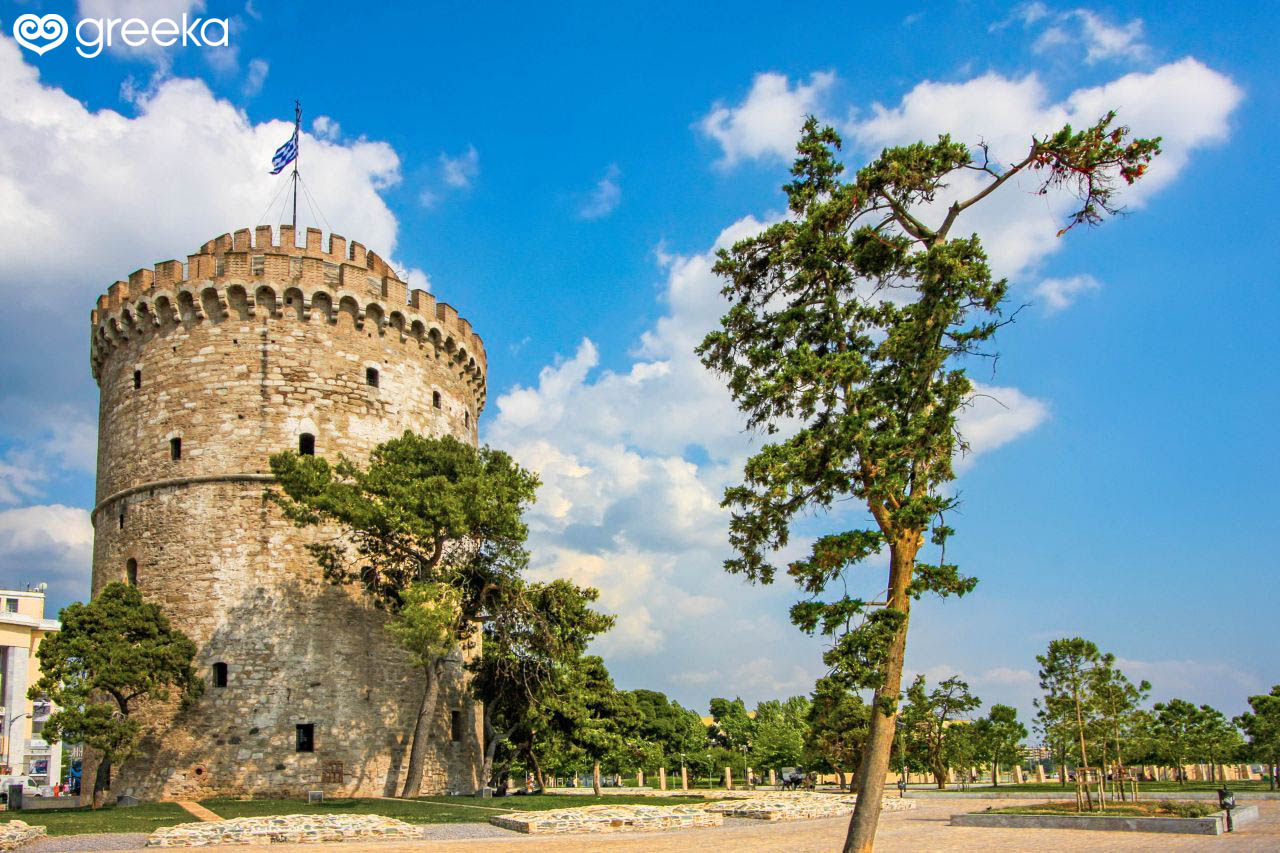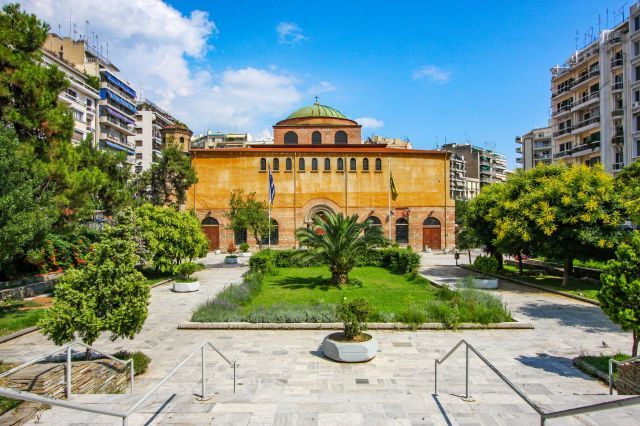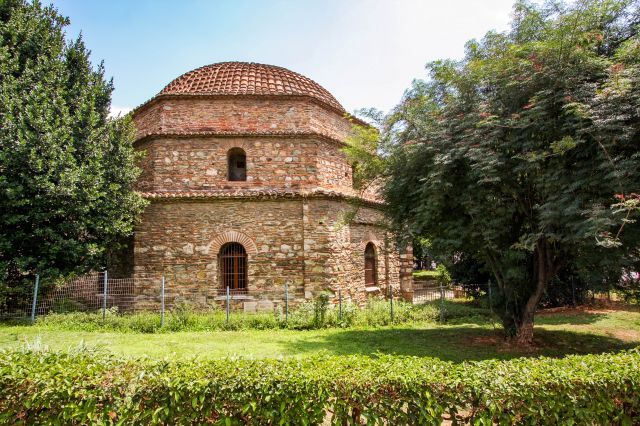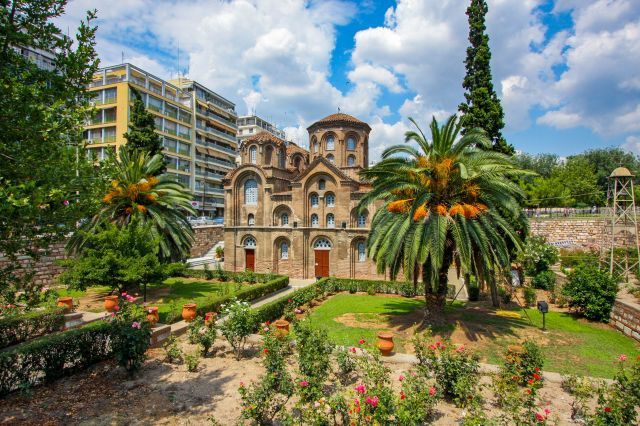Thessaloniki Sights & Attractions



Thessaloniki is the second largest town in Greece. It is located in northern Greece and its international airport makes it a nice gateway to the northern and central part of the Greek mainland. As Thessaloniki is a town with a long history, there are many sites to visit. The main sites of Thessaloniki date from Roman and Byzantine times, and include the Roman Arch of Galerius, the Monument of Rotonda, the Church of Saint Demetrius and the Medieval Castle. The symbol - and most important monument in Thessaloniki - is the White Tower, found at the famous Beach Promenade of the city. As Thessaloniki is geographically located in a central spot of the country, it is nice as an excursion base to places like Halkidiki, Kavala, and Meteora.
You can see below the best Sites in Thessaloniki. You can filter them by category and location.
Book your Car Rental: Book your Car rental at very advantageous prices with Greeka.com!

White Tower
CastlesThe White Tower, standing along the beach promenade, is the symbol of Thessaloniki. Constructed in the 16th century by the Ottomans, it was used as a fortress, a prison, and a university workshop. Today it hosts a museum.

Arch of Galerius
Ancient SitesMostly known as Kamara, the Arch of Galerius was constructed in 305 AD to celebrate and commemorate the final victory of Roman general Galerius over the Persians. This victory is the main theme of the carved scenes on this arch, which was connected with the Palace of Galerius and the Rotonda. Today, Kamara is a popular passageway and meeting point in Thessaloniki.

Rotonda Monument
MonumentsThe Rotonda (or Rotunda) is an impressive circular building in the center of Thessaloniki. It was originally constructed by the Roman general Galerius around 300 AD and in the late 4th century AD, it was turned into a Christian church and was decorated with nice frescoes. When the town was conquered by the Ottomans, Rotonda was turned into a mosque. In the early 19th century it became a church again and then a sculpture museum.

Church of Agios Dimitrios
ChurchesThe church of Agios Dimitrios(Saint Demetrius) is the most famous church in Thessaloniki. This is the patron saint of the town and its celebration on October 26th is a local holiday. This church dates back to the Byzantine Times and it was built on the exact location where Saint Demetrius martyred. In fact, the basement of the church is the place where the saint was tortured for his faith and died.

Archaeological Museum
MuseumsThe Archaeological Museum of Thessaloniki opened its doors in September 2006, after the restoration of the old building. Its aim is to present the way of life and socialization of the tribes that lived in Thessaloniki and the wider region of Macedonia from the prehistoric times till present. The permanent exhibitions of the Archaeological Museum are dedicated to various aspects and periods of time concerning Macedonia. The museum also organizes educational programmes for university students and kids.

Castle
CastlesThe Castle of Thessaloniki is also known as Yedi Kule or Heptapyrgion. This is a fortress from the Byzantine and the Ottoman era, standing just above the Old Town (Ano Poli). It has been used as the seat of the garrison commander until the late 19th century and as prison till 1989.

Church of Agia Sofia
ChurchesLocated in the city center, this is among the most important churches of Thessaloniki. It is not known where exactly the church of Saint Sofia was originally built. The most possible is that it was constructed after the Church of Saint Sofia in Constantinople, as they have many similarities in the architectural style. Some actually believe that the two churches were built by the same architect, Anthemios.

Roman Market
Ancient SitesThe Roman Market, close to the city center, was in function for 8 entire centuries, from the foundation of the town in the 5th century BC till the early Byzantine times, in the 5th century AD. Remains of a theatre, a square, an arched street, a mint, and a marketplace have been unearthed, while excavations and restoration works are being continued today.

Museum for Macedonian Struggle
MuseumsThe Museum of Macedonian Struggle is housed in a 19th-century Neoclassical building designed by the famous German architect Ernst Ziller, in the center of Thessaloniki. Through valuable exhibits, the Museum presents the fights of the Macedonians and generally people from northern Greece to set free from the Ottoman rule and incorporate to the Greek State.

Balkan Wars Museum
MuseumsThe two Balkan Wars that took place in the early 20th century is very important for Thessaloniki and the region of Macedonia in general. In fact, during the 1st Balkan War in 1912, the town was set free by the Ottoman rule that had lasted for about five centuries. To celebrate such historical events, the Museum of the Balkan Wars was created in 1999. It is located in a restored mansion at Yefira, a village about 25 km from Thessaloniki.

Byzantine Museum
MuseumsThe Museum of Byzantine Culture was established in 1989 and it opened to public in 1993. Today, the museum has 11 rooms in total that host permanent and temporary exhbitions as well as educational programmes. Some exhibits of the Byzantine Museum are housed in the White Tower, the symbol of Thessaloniki.

Church of Agios Nikolaos Orfanos
ChurchesLocated in Ano Poli, this small church is one of the oldest in Thessaloniki. It was built in the 14th century and contains valuable frescoes from the Byzantine times.

Bey Hamam
MonumentsBey Hamam is an old Ottoman bathhouse located along Egnatia Street, next to the church of Panagia Halkeon. Its name means "the Baths of Paradise". Originally built in 1444 by Sultan Murad II, this is among the most significant remains of the Ottoman occupation in Thessaloniki.

Macedonian Museum of Contemporary Art
MuseumsThe Macedonian Museum of Contemporary Art is housed in the Helexpo Exhibition Centre, on Egnatia st. The aim of this museum is to promote Greek and international contemporary art throughout the world and to make a contribution to the Greek cultural life.

Waterworks Museum
MuseumsThe Waterworks Museum is housed in the old water supply building that worked continuously from 1894 till 1978. It displays the history of water supply in Thessaloniki.

Church of Panagia Halkeon
ChurchesOn the southwest of the archaeological site of Roman Agora, there is the Byzantine church of Panagia Chalkeon. Its name means "Virgin Mary of Cooper Workers" in Greek, as there were cooper workshops living in the area.

Monastery of Vlatadon
ChurchesLocated in Ano Poli, this is the only monastery that works in the town of Thessaloniki. Constructed in the 14th century and dedicated to the Transfiguration of the Christ, only the katholicon (main church) survives today.

Cinema Museum
MuseumsThe aim of the museum is to collect, preserve and display items related to the history of cinema in Greece. The museum is based on the collection of Nikos Bililis, a cinematographer from Thessaloniki.

Church of the Holy Apostles
ChurchesThis beautiful 14th-century Byzantine church was designed on a cruciform ground plan, with five domes and elaborately patterned brickwork.

Concert Hall
OtherOne of the 2 building hosting the Concert Hall (M2) was designed by the famous Japanese architect Arata Isozaki.

Jewish Museum
MuseumsThe Jewish Museum of Thessaloniki is housed in the center of the town, in one of the few Jewish buildings that survived the great fire of 1917. Its exhibits aim to present visitors the vast history and culture of the Jews that lived in Thessaloniki since the 15th century. The first Jews came to Thessaloniki from Spain in 1492. They flourished for many centuries and integrated with the local life. However, 96% of the Jewish Community of Thessaloniki was extinguished by the Nazis in the Second World War. Today, the Jewish Community of Thessaloniki is very small.





